How to use Deco With Your Existing Router
Deco W3600 , Deco X20 , Deco X50-DSL , Deco BE65-5G , Deco M1300 , Deco X21 , Deco X68 , Deco HC4 , Deco WM9000 , Deco W3000 , Deco X25 , Deco Voice X50 , Deco E4R , Deco X58-4G , Deco E4S , Deco X5700 , Deco X4300 Pro , Deco W6000 , Deco BE25-Outdoor , Deco XE5300 , Deco M4 , Deco X3600 , Deco HX20 , Deco XE75 , Deco X1500 , Deco M3 , Deco X55 Pro , Deco X75 , DecoX5700 , Deco X50-4G , Deco X1500-4G , Deco BE85 , Deco X50-PoE , Deco WE10800 , Deco WB10800 , Deco X50-Outdoor , Deco Voice X20 , Deco X73-DSL , Deco W7200 , Deco X50-5G , Deco X5400 Pro , Deco P9 , Deco X80 , Deco P7 , Deco BE16000 , Deco HB6300-PoE , Deco X20-DSL , Deco 5G , Deco M5 Plus , Deco S1900 , Deco X20-4G , Deco PX50 , Deco BE95 , Deco BE5000 , Deco S7 , Deco X76 Plus , Deco X10-4G , Deco S4 , Deco BE65 Pro , Deco X5000 , Deco XE70 Pro , Deco BE11000 , Deco X90 , Deco X3000-5G , Deco W2400 , Deco X95 , Deco BE25 , Deco X50 , Deco X50 Pro , Deco W4500 , Deco X96 , Deco X55 , Deco E4 , Deco X10 , Deco E3 , Deco XM73 , Deco BE63 , Deco HB6300-Outdoor , Deco BE65 , Deco XE75 Pro , Deco XE200 , Deco X20-Outdoor , Deco X80-5G , Deco X55 Plus , Deco AC1200 , Deco M3W , Deco X60
Recent updates may have expanded access to feature(s) discussed in this FAQ. Visit your product's support page, select the correct hardware version for your device, and check either the Datasheet or the firmware section for the latest improvements added to your product. Please note that product availability varies by region, and certain models may not be available in your region.
If you have a router or a modem router at home already, you can connect the Deco to your existing router to extend the network.
Network Topology Examples
Generally, there are two typical network layouts in this scenario.
Topology 1:

Topology 2:

Deco supports 2 operation modes: Wireless Router Mode and Access Point Mode.
When your Deco is operating in Router mode, it’s suggested to only connect the main Deco to the existing router via Ethernet, a network loop may occur.
When your Deco is operating in Access Point mode, you can connect more than 1 Deco unit to the existing router directly via Ethernet.
You can change the operation mode after the Deco’s initial setup.
Before You Begin
1. To make ensure a smooth setup process, please disable the Power-Saving mode feature on your phone.
2. For iOS14 and above, enabling the Local Network option is required to complete the configuration process.
3. The guide linked below explains how to use your Deco with a modem router or a router. Please refer to this guide if you have a standalone modem.
Configuration Steps
Note: Features available in Deco may vary by model and firmware version. All steps and images described here are only examples and may not reflect your actual Deco experience.
In this case, the Deco X60 is used as an example.
1. Open Google Play (Android) or the App Store (iOS) to download the Deco App. Install the Deco app on your Android or iOS smartphone or tablet.

2. Open the Deco App. Log in or sign up to set up a TP-Link ID.
Note: If you already have a TP-Link Cloud account, you can log in with your account.
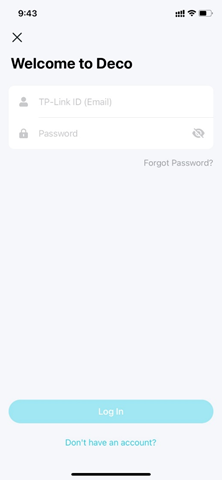
3. Tap Let’s begin.
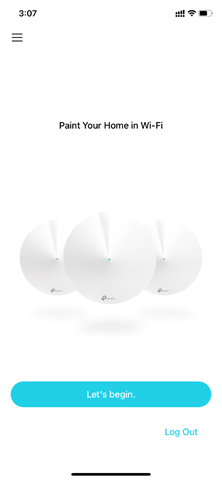
4. Select your Deco model.
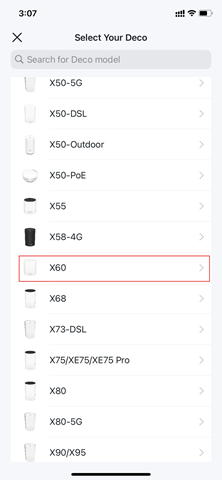
5. Unpack the contents of the box. Once you verify you have everything you need, move on to the next step.
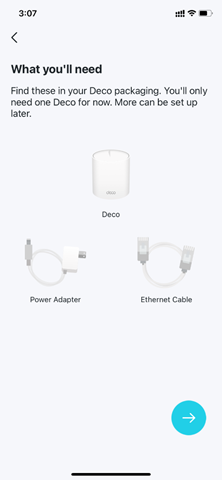
6. Connect one of your Deco units to your router via Ethernet cable directly.
Note: You can skip the below steps if you connect the Deco to your router. The instructions on the Deco app are for how to use your Deco with a modem.
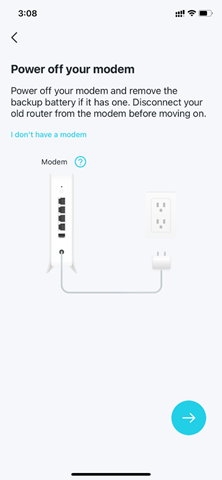
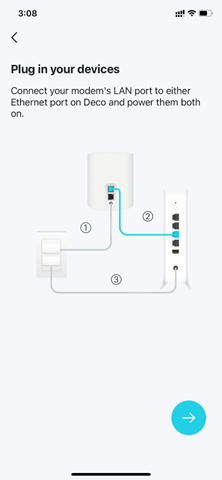
7. Check your router.
Make sure that you can access the Internet from the existing router.
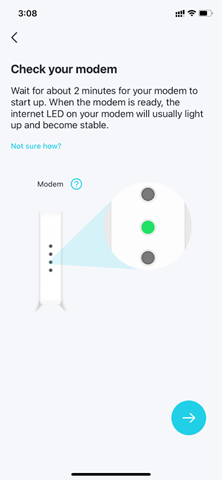
8. Wait until the Deco’s status LED pulses blue.
Note: If the LED is not pulsing blue, press the RESET on Deco for one second, and the LED will turn yellow. Then, please wait for about 2 minutes until the LED begins pulsing blue and then continue.
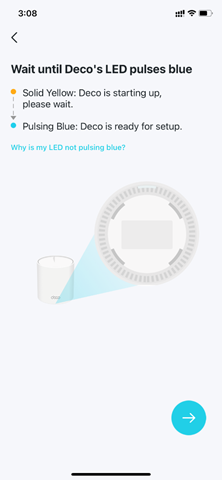
9. Connect your phone to the Deco’s default SSID printed on the bottom label (such as Deco_ XXXX).
Note: Some phones may connect to the default SSID automatically. The Deco app will notify you if it detects you are connected to the Deco Mesh.
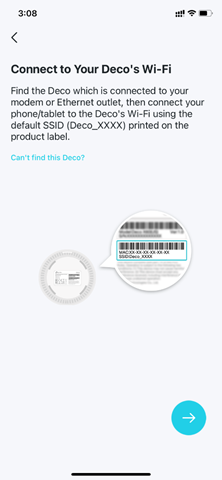
10. Assign your connected Deco to a room. The location will be also used as this Deco’s name.
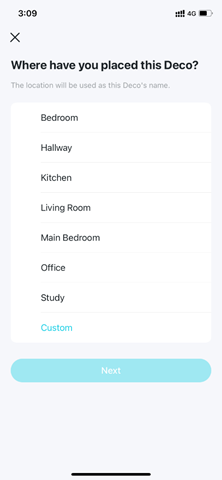
11. Select "Dynamic IP" as the internet connection type and leave "IPTV/VLAN Settings" turned off, then proceed to the next step.
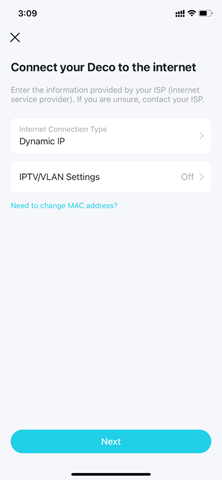
12. Create your Wi-Fi network name and password.
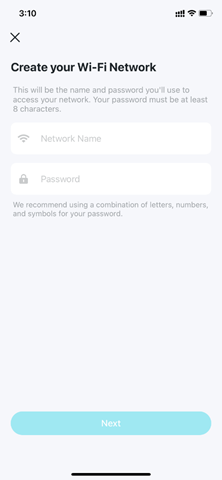
13. Connect your phone/tablet to the Deco’s Wi-Fi.
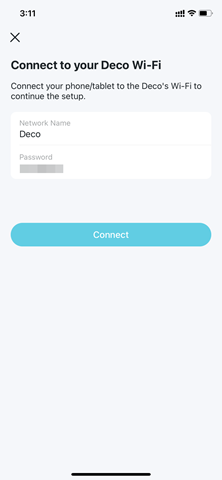
14. At this point, the setup is complete. You may now connect all your devices to the Deco network.
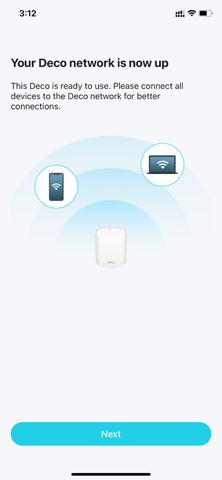
15. If you have other Deco units in the same package:
- For Wi-Fi 6 or above Decos, simply power on these Decos in the same room as the main Deco, and they will be added to the network within 2 minutes.
- For other models, you can add more Decos using the instructions in this FAQ.
How to add an additional unit to your Deco network
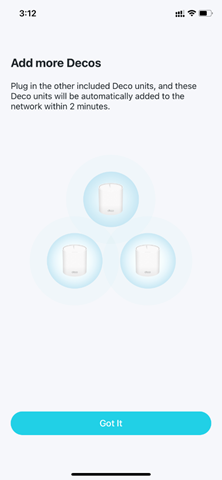
After setting up the additional Deco nodes, you can relocate these Decos to locations of your preference.
Related FAQs
Is this faq useful?
Your feedback helps improve this site.
What’s your concern with this article?
- Dissatisfied with product
- Too Complicated
- Confusing Title
- Does not apply to me
- Too Vague
- Other
Thank you
We appreciate your feedback.
Click here to contact TP-Link technical support.
TP-Link Community
Still need help? Search for answers, ask questions, and get help from TP-Link experts and other users around the world.
We have updated our Policies. Read Privacy Policy and Terms of Use here.
This website uses cookies to improve website navigation, analyze online activities and have the best possible user experience on our website. You can object to the use of cookies at any time. You can find more information in our privacy policy .
We have updated our Policies. Read Privacy Policy and Terms of Use here.
This website uses cookies to improve website navigation, analyze online activities and have the best possible user experience on our website. You can object to the use of cookies at any time. You can find more information in our privacy policy .
Basic Cookies
These cookies are necessary for the website to function and cannot be deactivated in your systems.
TP-Link
accepted_local_switcher, tp_privacy_base, tp_privacy_marketing, tp_smb-select-product_scence, tp_smb-select-product_scenceSimple, tp_smb-select-product_userChoice, tp_smb-select-product_userChoiceSimple, tp_smb-select-product_userInfo, tp_smb-select-product_userInfoSimple, tp_top-banner, tp_popup-bottom, tp_popup-center, tp_popup-right-middle, tp_popup-right-bottom, tp_productCategoryType
Livechat
__livechat, __lc2_cid, __lc2_cst, __lc_cid, __lc_cst, CASID
Youtube
id, VISITOR_INFO1_LIVE, LOGIN_INFO, SIDCC, SAPISID, APISID, SSID, SID, YSC, __Secure-1PSID, __Secure-1PAPISID, __Secure-1PSIDCC, __Secure-3PSID, __Secure-3PAPISID, __Secure-3PSIDCC, 1P_JAR, AEC, NID, OTZ
Analysis and Marketing Cookies
Analysis cookies enable us to analyze your activities on our website in order to improve and adapt the functionality of our website.
The marketing cookies can be set through our website by our advertising partners in order to create a profile of your interests and to show you relevant advertisements on other websites.
Google Analytics & Google Tag Manager
_gid, _ga_<container-id>, _ga, _gat_gtag_<container-id>
Google Ads & DoubleClick
test_cookie, _gcl_au
Meta Pixel
_fbp
Crazy Egg
cebsp_, _ce.s, _ce.clock_data, _ce.clock_event, cebs
lidc, AnalyticsSyncHistory, UserMatchHistory, bcookie, li_sugr, ln_or


_Overview_normal_20211130005706l.png)